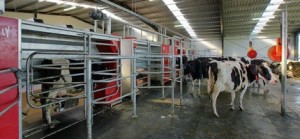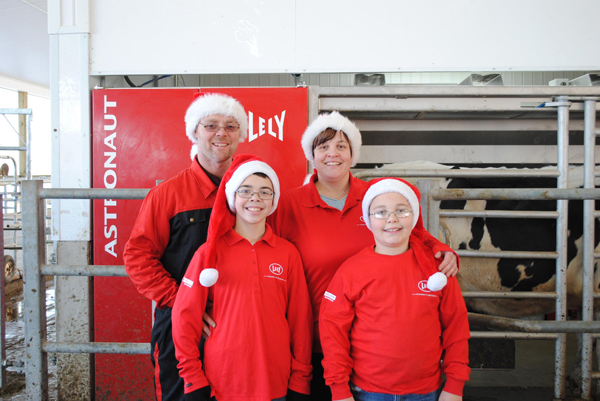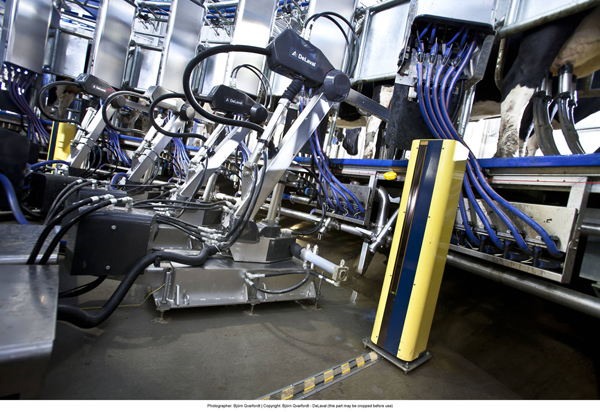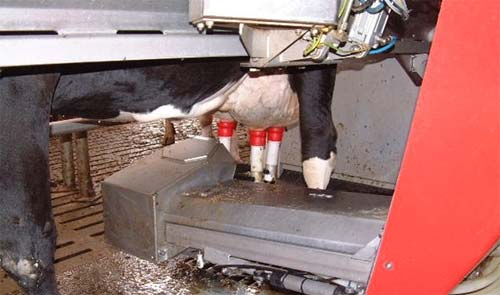Everyone agrees that dairy farming is hard work 24-7. Effective labour management is not only a financial cost but it also impacts herd health and production. The past decade has seen increased uptake and considerable improvements in robotic milking. This has been a direct outgrowth of concerns relating to finding, training and financing farm labour.

These gentlemen generously shared their insights with The Bullvine.
WHY DID YOU CHOOSE ROBOTS?
The simplest answer, in each case, boiled down to “Robots are the right choice for labor efficiency”. Of course, there’s no such thing as a truly one size fits all simple answer and that’s where Francisco Rodriguez gives us a good method for determining if robots are right for your situation. He recommends this: “Ask yourself: ‘Why do I want to buy Robots? If the answer is “I want to be more efficient at managing my herd, while building a sustainable operation and working smarter rather than harder” then you will succeed. However, if the answer is ‘I don’t want to spend time in the barn, robots will help me to do everything’ then sell the cows and play golf, because you still you need to manage your business and work with your cows, whether you use robots or not.”
All three Ontario dairymen went to robots to address labour needs and to find more time to spend with family or to focus on crucial areas of the operation. Gerrit was competing for labour with Toyota and robotics allows his hired staff to have better hours and use their time more productively. For example there is now less time moving cattle and better hours. It took a minimum of three people for each milking (3x). As well, all four gentlemen felt that automated milking is where it is at and especially where it will be at in the future. They made the leap.

Terry Howell & family
HOW DO ROBOTS WORK FOR YOU?
Francisco knows robotics from setup to output and is one of the best North American resources with experience in Colombia as well. He gives this overview. “Automatic milking a proven technology. After 20 years more than 1.2 million dairy cows are milked by robots globally. What makes the main difference from farm to farm is having a well designed barn managed by a knowledgeable proactive dairyman.” He urges anyone considering robotics to “Make sure you choose a layout that fits into your philosophies and management style. This is the key. The best layouts are simple and always expandable.”
Roger Wikkerink milks 70 cows and reports that he “likes cows and working with them”. In his setup, all the animals of all ages are under one roof and when someone is not there, he has cameras to monitor the barn. He set up his first robot ten years ago and used it for 8.5 years. For the past year and a half he has upgraded to the newest technology and reports that “There have been many improvements.”
Gerrit Wensink installed six robots four and half years ago, using three for fresh and three for pregnant cows. He sees his most important role as that of manager and feels that is the highest priority regardless of your milking system. He was challenge and has adapted to working with technology after facing labour that became too expensive in competition with nearby Toyota.
Terry Howell is the newest of our group to take up robotics and milks 60 cows and has one robot. Has 14 months experience under his belt and reports “ I had to do considerable thinking about how to do things better.” and, like the others, found that robotics provided the best opportunity for his situation.
ROBOTS RANK HIGH ON PERFORMANCE
Whether it is with 60 cows in Ontario or 1000+ cows in the US, robotics is meeting and surpassing the expectations of the farmers who have adopted the technology. As mentioned, Roger moved with enhancements and upgraded his robots and Terry is so pleased, at this point, that he has purchased more quota.
Francisco expands on what robots can mean to a dairy operation. “Robots are living up to expectations. They are reliable and becoming more reliable all the time. Robots gives (me) family time and mean not having to hire more labour. A robot milking 60-70 cows for one family plus young stock, gives the farm operator time to observe and manage and gives more time to work with fresh cows or animals that need attention. The breeder works as a manager not the labourer. Robotics is a great tool for business oriented farmers” is how he sums up the benefits.
From the cattle management point of view there are several observations. “Teat ends are much better, cows are not over milked – robot takes off when each teat is done.” Even the environment is changed. “It is quiet in the barn.” This peaceful setting now means that some routine events like bedding, vet checks, herd health, and hoof trimming, can represent enough of a disruption in cows’ milking schedules that they may drop in production at those times.” However all agree that the benefits of a more flexible personal schedule and the fact that they can get “more milk from less cows” are benefits that definitely weigh significantly on the positive side.
SIRE SELECTION FOR ROBOTIC MILKING
The area of specific selection for robotics is relatively new. For Roger Wikkerink it is not an issue and therefore has not changed his bull selection criteria. “I still require that bulls be +12 for Conformation. They must be positive for component percentages. Specifically I want to minimize to minimize use of Oman blood because they lack dairy strength and the median suspensary ligament is not as strong as I would like.” He details his selection. “I am using Goldwyn (still some semen) and his sons – Lauthority and Lavanguard then Dempsey, Fever, Sid, Damion and Windbrook. I have used Shottle but only later – none milking yet, … sires must have type and + components.” He adds, “I must like the pedigree of any sire I use. My preference is to use daughter proven sires.”
Gerrit Wessink reports his method. “Every proof run I sit down and look the bulls over. I pick out one main bull to use for the next four months. Besides ONE proven bull I also use 3-5 high genomic bulls for one proof time (4 months). If I need more variety I do it thru choosing more genomic bulls.” This spreads the risk. “I have been using Manifold – now have 70 milking daughters – and they are fantastic. They will not be the kind for the show ring but I reviewed them (yesterday) and they are significant plus for BCAF + BCAP (that’s what I like). ” Over and over the robotics users emphasize that you want to meet your individual goals with the system. Gerrit also has good news for those concerned about calving ease. “You can in one generation get calving easy into a herd. That is very necessary when staff are not always present in the barn.”
With experience in very large commercial herds, in and out of North America, Francisco looks feels character is a trait to consider. “Aggressive cows are a must since segregating cows in groups by lactation stage is not recommended and according to practical conditions small farms milking less than 60 cows-one robot will have limitations to house young and adult cows in different groups. If the cows don’t have the strength and willingness to compete, they won’t have the same opportunity to perform in a voluntary milking system like this.” He also points out the feet and legs are vital to getting the most from the robotic system. “If cows don’t have good mobility in a system where nobody is there to push them to the parlour, there is no way they will access the robot to get milked by their own.”
For Terry Howell sire selection is simplified in his management system. Knowing, for one example, that udders that are too deep or too shallow can both be a problem, he uses an AI mating program to select sires. In that program he can set the parameters he wants and the program will select sires according to cow his particular parameters.
Resources for Breeders
North American AI organizations are recommending sires to use in robotic herds. Robot Ready Sires from Semex is one example. DeLaval is developing a performance index. Francisco outlines what they are working toward. “Sires that work best in the system are identified. The Performance index measures how fast and easy the robot can attach the teat cups to a cow with an exclusive indicator relating to attachment. Cows over 100% are great for robots, below 99% means they are losing efficiency. Sometimes there are cows with very high milking speed but really poor attachment times and that makes them inefficient in a robotic system.” There are undoubtedly great developments ahead despite the ongoing challenge of the heritability of selecting for a total performance. It is still very low.
The Bullvine Bottom Line
All four gentlemen are excited about the potential of robotic milking and are very satisfied with the choice of going to robotics. Terry Howell is enthusiastic, “So much so that I have just bought more quota.” Gerritt, Wessink and Rodriguez emphasize how robotics allows them and their work force to focus on management.
Management, regardless of the system your dairy uses, is the modern day #1 priority. Robots allow this focus in a sustainable, effective and financially realistic way. They all foresee this as a growing trend in a dairy industry that is moving toward “smart and sustainable” dairy farm management.



















Leave a Reply
You must be logged in to post a comment.